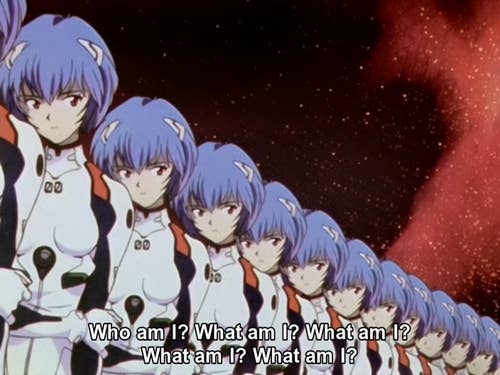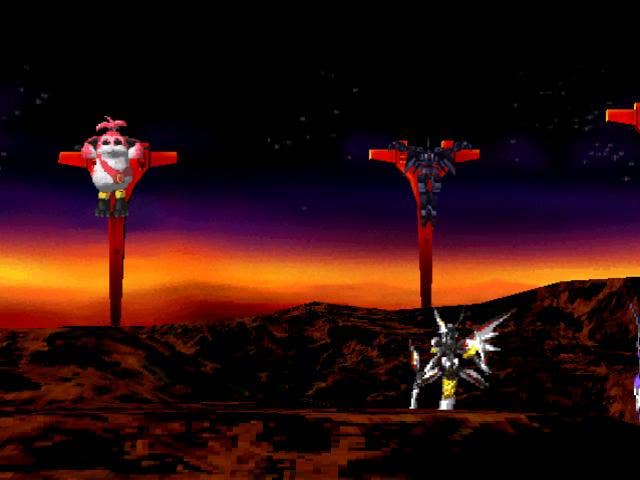Why Xenogears Remains Enduringly Popular on its 20th Anniversary
Looking back on a crazy but enduring entry in the RPG canon.
This article first appeared on USgamer, a partner publication of VG247. Some content, such as this article, has been migrated to VG247 for posterity after USgamer's closure - but it has not been edited or further vetted by the VG247 team.
I guess it's only appropriate that I happen to be watching Neon Genesis Evangelion as I sit down to revisit Xenogears, which celebrated its 20th anniversary on Sunday.
Animator Hideaki Anno's classic mech anime had a disproportionate impact on Japanese pop culture, making it suddenly cool for anime to focus on darker themes like depression, religion, and Jungian psychology. And games were not immune to its impact.

It appeared at a heady time for game developers. The popularization of polygonal engines allowed for movie-like camera angles, and for the first time cutscenes could depict the full breadth of a developer's vision. Freed from the perceived shackles of sprite-based storytelling, auteurs like Hideo Kojima suddenly had access to a much larger canvass.
It was in this period that Tetsuya Takahashi was first handed the reins of development. Having come up in the 16-bit era, Takahashi had worked under Final Fantasy creator Hironobu Sakaguchi on many of Square's best-known 16-bit games, including Final Fantasy IV and Secret of Mana. By 1996, Sakaguchi had moved into a senior post with SquareSoft, allowing a new generation of game developers to step up, including Takahashi.
Takahashi and others like him had been frustrated by the constraints of the 16-bit era. More than that, they wanted to make something other than Final Fantasy, which had been the studio's bread and butter since the late '80s.
"If someone displayed leadership skills, they would be given the independence of having their own team," Sakaguchi recalled in an Iwata Asks interview. "At the same time, they would often ask me: 'Is Final Fantasy all this company can let me create?' I used to worry about that."
Takahashi and his wife Soraya Saga had originally submitted the idea that would become Xenogears as an idea for Final Fantasy VII, only for it to be rejected for being too dark. Upon forming his own team, he and Saga repurposed it for a new game: Xenogears.
Saga recalled in a 2010 interview with Siliconera, "The works of Nietzsche, Freud and Jung happened to be part of common interests I shared with Takahashi. Xenogears is basically a story about 'where do we come from, what are we, where are we going.' In that respect, we were inspired by those concepts a lot."
The story they developed featured an amnesiac painter named Fei Fong Wong who falls into the cockpit when his village comes under attack by Gears—the mechs of the Xenogears world.
It's initially your fairly typical story of a band of renegades battling an evil empire; but as the layers of Fei's personality are progressively peeled away, the scope of the story steadily expands until it encompasses the entirety of human history, ultimately explaining why the first cutscene shows a starship seemingly going berserk and killing its own passengers.
While hardly a direct copy of Evangelion, it's not hard to see the similarities between the two. Both lean heavily on religious iconography, from crucifixions to the Lance of Loginus. They also delve deep into the psychology of their protagonists, Asuka's flashbacks to her mother's descent into madness mirroring Fei's own... troubled... family life. They even had similarly troubled production histories, with Evangelion resorting to abstract sketches for its final episodes, and Xenogears relying on text to finish its infamous Disc 2.
Not surprisingly, they appealed to similar audiences. Anime was unquestionably on the rise when Xenogears was released in the U.S. Final Fantasy VII had successfully popularized console RPGs in the west the year before, turning a whole new generation onto the look and feel of anime. Pokemon was in the process of exploding in the west. Gaming audiences were hungry for complex Japanese-developed RPGs with strong anime influences, and Xenogears fit the bill perfectly.

That it almost wasn't released at all only added to its mystique. In late 1997, a Square spokesperson told IGN that "there were issues concerning religious themes" that would prevent its release. Behind the scenes, localization specialists were leaving Xenogear due to its controversial content, ultimately leaving the script to just one translator—Richard Honeywood. Honeywood had worked on SaGa Frontier and Parasite Eve, but the Xenogears script was absolutely massive.
"It was the project from hell," Honeywood told 8-4 Play in 2011. "Translators walked off it. One [reason] was that it was too technical... and....the other was the religious content. It was a game, where, at the end of the game you basically kill God. And—a secret thing—back then, they actually called it Yahweh."
The name of the final boss was ultimately changed from "Yahweh" to "Deus."
In hindsight, it was a miracle that Xenogears came out at all. But when it finally did make it to North America, its controversial roots lent it a certain amount of cachet. Final Fantasy VII had been big and complex, but Xenogears was even bigger. And in the late '90s, having a labyrinthine story loaded with complex symbols was considered a badge of honor.
Xenogears was ultimately released in North America in October 1998. In Japan, Takahashi was still recovering from its brutal development cycle. Square's strict deadlines had forced him to cut much of the game's second half, and the push to get it out the door had taken a physical toll on him and his staff.
"It's already been a quick six months since the launch of Xenogears," Takahashi said in Xenogears Perfect Works. "Looking back on it now, it's been absolutely chaotic, and there are some things about the game and some things I've said I find almost unbearably embarrassing."
Xenogears' compromises would ultimately become a topic of heated debate among RPG fans. Detractors have called it messy and pretentious, with Disc 2 being the point where it completely falls apart. Supporters acknowledge its flaws, but praise its willingness to wade so deep into the waters of religious symbolism, philosophy, and psychology.
Twenty years later, we're still debating it.
The Legacy of Xenogears
I ultimately finished Xenogears in 2000, roughly a year and a half after its initial release. I was taken with its scope, but frustrated with its execution. One of my enduring memories of Xenogears is wrestling with the platforming, falling time and again as I missed my jumps in the Tower of Babel.
Even then it was apparent that Xenogears was a budget project. With only a small, inexperienced team and a limited budget at his disposal, Takahashi had to make due with sprites rather than a full-blown 3D engine. Interestingly, this compromise has arguably allowed Xenogears to hold up better than the likes of Final Fantasy VII, mostly because sprites are timeless.
I was taken by its look, mostly because sprites were fairly rare in big releases in 1998, and even more taken with its battle system. Like the rest of Xenogears, it was messy and convoluted, and its system for unlocking Deathblows—Xenogears' combo finishers—was poorly explained, but I enjoyed the fighting game-like feel of it. Compared to the menu-driven RPGs of the time, it felt flashy and immediate. Amusingly, I actually preferred the ground battles to the more technically impressive Gear fights, if only because I preferred the satisfaction of landing a Deathblow. I cheered whenever I fought a boss on foot.

When it started to get immensely weird in the latter half of the first disc, I accepted it as par for the course. I had only recently played Final Fantasy VII, which had messed with concepts as fundamental as identity, even going so far as to feature a sequence in which Tifa helps Cloud reclaim his shattered personality. Xenogears felt like an expansion of that with the nearly hour-long cutscenes (!) in which Fei reunites his id, ego, and superego being at the very cutting edge of game development.
Xenogears ultimately received glowing reviews when it came out. In a period of experimentation, Xenogears was at the bleeding edge of video game storytelling, or so we believed. It was only later that the tide began to turn a bit, with USgamer alum Jeremy Parish being among those to point out its plodding plot and numerous other problems. In recounting the history of the Xenoverse back in 2015, Bob Mackey referred to it as a "lost opportunity."
Nevertheless, Xenogears has managed to remain enduringly popular even today. On Metacritic, it enjoys 55 positive user reviews to only two negative ones. One fan wrote in 2017, "An unbeaten, powerful masterpiece even today. The music, the characters, the amazing plot, the dual-battle system, the places and the feeling that you have been playing something really enormous and epic. Drop the controller and you will keep thinking about the plot. But this is not a game for any player. True RPG lovers and purists will enjoy this game like nothing else even after so many years."
Today, Xenogears is as much a symbol as anything. It hearkens back to a time when anime was still getting its foothold in the U.S., and Square was still the acknowledged king of gaming. For gamers of a certain age, it embodies a very particular period in the medium's history, and it carries with it a certain hardcore cachet that goes a long way with gamers.
I can't really say that it holds up, not when it has a scene where the mechs are literally crucified, but it's still lodged in my memory. How many games span thousands of years of history? It was a world so big that Takahashi at one point said it was the fifth chapter of a much larger series.
We can't help but be drawn to messy but singular works of art, whether Evangelion, Xenogears, or even Michael Cimino's infamous Heaven's Gate, which has enjoyed a bit of a revival of late. Often their flaws only serve to accentuate their soaring creativity, their sweeping ambition pushing the artists who work on them to the limit. Yasunori Mitsuda, arguably the best video game composer ever, produced what might be his finest soundtrack with Xenogears.
It remains an indelible part of the RPG canon—a unique, crazy, and beloved part of gaming heritage. A game that borrowed from everything from Soylent Green to Arthur C. Clarke's Childhood's End to, yes, Neon Genesis Evangelion. Failure or not, we won't soon forget it.










